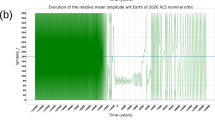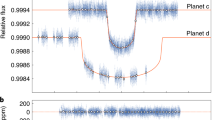Abstract
Models of the Solar System’s evolution show that almost all the primitive material leftover from the formation of the planets was ejected to the interstellar space as a result of dynamical instabilities1. Accordingly, minor bodies should also be ejected from other planetary systems and should be abundant in the interstellar space2, giving hope for their direct detection and detailed characterization as they penetrate through the Solar System3,4. These expectations materialized on 19 October 2017 ut with the Panoramic Survey Telescope and Rapid Response System’s discovery of 1I/‘Oumuamua5. Here, we report homogeneous photometric observations of this body from Gemini North, which densely cover a total of 8.06 h over two nights. A combined ultra-deep image of 1I/‘Oumuamua shows no signs of cometary activity, confirming the results from other, less sensitive searches6,7,8,9. Our data also show an enormous range of rotational brightness variations of 2.6 ± 0.2 mag, larger than ever observed in the population of small Solar System objects, suggesting a very elongated shape of the body. Most significantly, the light curve does not repeat exactly from one rotation cycle to another and its double-peaked periodicity of 7.56 ± 0.01 h from our data is inconsistent with earlier determinations6,7,10,11,12. These are clear signs of a tumbling motion, a remarkable characteristic of 1I/‘Oumuamua’s rotation that is consistent with a collision in the distant past. Bearing marks of a violent history, this first-known interstellar visitor tells us that collisional evolution of minor body populations in other planetary systems might be common.
This is a preview of subscription content, access via your institution
Access options
Access Nature and 54 other Nature Portfolio journals
Get Nature+, our best-value online-access subscription
$29.99 / 30 days
cancel any time
Subscribe to this journal
Receive 12 digital issues and online access to articles
$119.00 per year
only $9.92 per issue
Buy this article
- Purchase on Springer Link
- Instant access to full article PDF
Prices may be subject to local taxes which are calculated during checkout




Similar content being viewed by others
References
Woolum, D. S. & Cassen, P. M. in Encyclopedia of the Solar System (eds Weissman, P. R., McFadden, L.-A. & Johnson, T. V.) 27–28 (Academic Press, San Diego, 1999).
Moro-Martín, A., Turner, E. L. & Loeb, A. Will the large synoptic survey telescope detect extra-solar planetesimals entering the Solar System? Astrophys. J. 704, 733–742 (2009).
Sekanina, Z. A probability of encounter with interstellar comets and the likelihood of their existence. Icarus 27, 123–133 (1976).
Stern, S. A. On the number density of interstellar comets as a constraint on the formation rate of planetary systems. Publ. Astron. Soc. Pac. 102, 793–795 (1990).
Williams, G. MPEC 2017-U181: Comet C/2017 U1 (PANSTARRS) (International Astronomical Union, 2017); https://www.minorplanetcenter.net/mpec/K17/K17UI1.html.
Meech, K. J. et al. A brief visit from a red and extremely elongated interstellar asteroid. Nature 552, 378–381 (2017).
Jewitt, D. et al. Interstellar interloper 1I/2017 U1: observations from the NOT and WIYN telescopes. Astrophys. J. Lett. 850, L36 (2017).
Ye, Q.-Z., Zhang, Q., Kelley, M. S. P. & Brown, P. G. 1I/2017 U1 (‘Oumuamua) is hot: imaging, spectroscopy, and search of meteor activity. Astrophys. J. Lett. 851, L5 (2017).
Knight, M. M. et al. On the rotation period and shape of the hyperbolic asteroid 1I/‘Oumuamua (2017 U1) from its lightcurve. Astrophys. J. Lett. 851, L31 (2017).
Bolin, B. T. et al. APO time-resolved color photometry of highly elongated interstellar object 1I/‘Oumuamua. Astrophys. J. Lett. 852, L2 (2018).
Bannister, M. T. et al. Col-OSSOS: colors of the interstellar planetesimal 1I/‘Oumuamua. Astrophys. J. Lett. 851, L38 (2017).
Feng, F. & Jones, H. R. A. ‘Oumuamua as a messenger from the local association. Astrophys. J. Lett. 852, L27 (2018).
Fukugita, M. et al. The Sloan Digital Sky Survey photometric system. Astron. J. 111, 1748–1756 (1996).
Stellingwerf, R. F. Period determination using phase dispersion minimization. Astrophys. J. 224, 953–960 (1978).
Drahus, M. & Waniak, W. Non-constant rotation period of comet C/2001 K5 (LINEAR). Icarus 185, 544–557 (2006).
Fitzsimmons, A. et al. Spectroscopy and thermal modelling of the first interstellar object 1I/2017 U1 ‘Oumuamua. Nat. Astron. 2, 133–137 (2018).
Fraser, W. C. et al. The tumbling rotational state of 1I/‘Oumuamua. Nat. Astron. https://doi.org/10.1038/s41550-018-0398-z (2018).
Pravec, P. & Harris, A. W. Fast and slow rotation of asteroids. Icarus 148, 12–20 (2000).
Warner, B. D., Harris, A. W. & Pravec, P. The asteroid Lightcurve Database. Icarus 202, 134–146 (2009).
Hapke, B. Theory of Reflectance and Emittance Spectroscopy (Cambridge University Press, New York, 2012).
Hilton, J. L. in Asteroids III (eds Bottke, W. F. et al.) 103–112 (University of Arizona Press, Tucson, 2002).
Pravec, P. et al. Tumbling asteroids. Icarus 173, 108–131 (2005).
Samarasinha, N. H. Rotational excitation and damping as probes of interior structures of asteroids and comets. Meteorit. Planet. Sci. 43, 1063–1073 (2008).
Belton, M. J. S., Julian, W. H., Anderson, A. J. & Mueller, B. E. A. The spin state and homogeneity of comet Halley’s nucleus. Icarus 93, 183–193 (1991).
Belton, M. J. S. et al. The complex spin state of 103P/Hartley 2: kinematics and orientation in space. Icarus 222, 595–609 (2013).
Hudson, R. S. & Ostro, S. J. Shape and non-principal axis spin state of asteroid 4179 Toutatis. Science 270, 84–86 (1995).
Samarasinha, N. H., Mueller, B. E. A., Belton, M. J. S. & Jorda, L. in Comets II (eds Festou, M., Keller, H. U. & Weaver, H. A.) 281–299 (University of Arizona Press, Tucson, 2004).
Pravec, P. et al. The tumbling spin state of (99942) Apophis. Icarus 233, 48–60 (2014).
Bottke, W. F. et al. Linking the collisional history of the main asteroid belt to its dynamical excitation and depletion. Icarus 179, 63–94 (2005).
Kim, Y., Ishiguro, M., Michikami, T. & Nakamura, A. M. Anisotropic ejection from active asteroid P/2010 A2: an implication of impact shattering on an asteroid. Astron. J. 153, 228 (2017).
Hook, I. M. et al. The Gemini-North Multi-Object Spectrograph: performance in imaging, long-slit, and multi-object spectroscopic modes. Publ. Astron. Soc. Pac. 116, 425–440 (2004).
Drahus, M. et al. Fast rotation and trailing fragments of the active asteroid P/2012 F5 (Gibbs). Astrophys. J. Lett. 802, L8 (2015).
Laher, R. R. et al. Aperture photometry tool. Publ. Astron. Soc. Pac. 124, 737–763 (2012).
Eisenstein, D. J. et al. SDSS-III: massive spectroscopic surveys of the distant Universe, the Milky Way, and extra-solar planetary systems. Astron. J. 142, 72 (2011).
Bowell, E. et al. in Asteroids II (eds Binzel, R. & Gehrels, T.) 524–556 (University of Arizona Press, Tucson, 1989).
Luu, J. & Jewitt, D. On the relative numbers of C types and S types among near-earth asteroids. Astron. J. 98, 1905–1911 (1989).
Masiero, J. Palomar optical spectrum of hyperbolic near-earth object A/2017 U1. Preprint at https://arxiv.org/abs/1710.09977 (2017).
Helfenstein, P. & Veverka, J. in Asteroids II (eds Binzel, R. & Gehrels, T.) 557–593 (University of Arizona Press, Tucson, 1989).
Davidsson, B. J. R. Tidal splitting and rotational breakup of solid biaxial ellipsoids. Icarus 149, 375–383 (2001).
Pravec, P., Harris, A. W. & Michalowski, T. in Asteroids III (eds Bottke, W. F. et al.) 113–122 (University of Arizona Press, Tucson, 2002).
Sharma, I., Burns, J. A. & Hui, C.-Y. Nutational damping times in solids of revolution. Mon. Not. R. Astron. Soc. 359, 79–92 (2005).
Breiter, S., Rożek, A. & Vokrouhlický, D. Stress field and spin axis relaxation for inelastic triaxial ellipsoids. Mon. Not. R. Astron. Soc. 427, 755–769 (2012).
Acknowledgements
The findings of this paper are based on observations obtained at the Gemini Observatory, which is operated by the Association of Universities for Research in Astronomy , Inc., under a cooperative agreement with the NSF on behalf of the Gemini partnership: the National Science Foundation (United States), the National Research Council (Canada), CONICYT (Chile), Ministerio de Ciencia, Tecnología e Innovación Productiva (Argentina), and Ministério da Ciência, Tecnologia e Inovação (Brazil). We are indebted to the director of the Gemini Observatory, L. Ferrarese, for rapid evaluation and approval of our director’s discretionary time request. We also thank our telescope operator, A. Smith, for excellent work including real-time brightness monitoring of the target, and other Gemini Observatory staff members for vital contributions to making the GMOS-N observations possible. Special thanks to the ‘Alopeke instrument team for flexibility and cooperation during the observations, which disrupted their commissioning work. M.D., P.G. and B.H. are grateful for support from the National Science Centre of Poland through SONATA BIS grant number 2016/22/E/ST9/00109 to M.D.
Author information
Authors and Affiliations
Contributions
P.G. suggested the target. M.D., P.G., B.H. and S.K. designed the observations and wrote the telescope time proposal. P.G. and M.D. carried out the image cleaning and photometry. W.W. reduced the raw images and performed light curve modelling. M.D. led data analysis and writing of the paper with contributions from P.G. and W.W., S.X. assisted in proposal writing and organization of the observations. All authors checked the work and proofread the paper.
Corresponding authors
Ethics declarations
Competing interests
The authors declare no competing interests.
Additional information
Publisher’s note: Springer Nature remains neutral with regard to jurisdictional claims in published maps and institutional affiliations.
Supplementary information
Supplementary Information
Supplementary Figures 1–12.
Rights and permissions
About this article
Cite this article
Drahus, M., Guzik, P., Waniak, W. et al. Tumbling motion of 1I/‘Oumuamua and its implications for the body’s distant past. Nat Astron 2, 407–412 (2018). https://doi.org/10.1038/s41550-018-0440-1
Received:
Accepted:
Published:
Issue Date:
DOI: https://doi.org/10.1038/s41550-018-0440-1
This article is cited by
-
‘Oumuamua and meta-empirical confirmation
Foundations of Physics (2022)
-
Gaseous atomic nickel in the coma of interstellar comet 2I/Borisov
Nature (2021)
-
Tidal fragmentation as the origin of 1I/2017 U1 (‘Oumuamua)
Nature Astronomy (2020)
-
The natural history of ‘Oumuamua
Nature Astronomy (2019)
-
Initial characterization of interstellar comet 2I/Borisov
Nature Astronomy (2019)



